What Is It Like To Live Near Chernobyl Today?
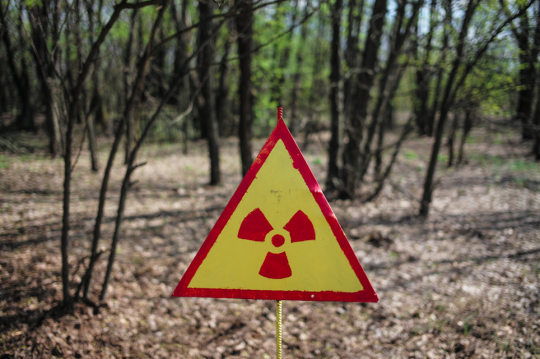
Danger: A radiation sign outside a forest near Chernobyl (Rex)
This week marks the 30th anniversary of the Chernobyl disaster, that saw a nuclear power plant go into meltdown before exploding and sending lethal dust into the air.
A staggering 56,700 square miles of Ukraine, Belarus and Russia was covered by the fallout, forcing hundreds of thousands of residents to leave their homes for good in what is, to date, the world’s worst nuclear accident.
The nuclear fire lasted 10 days, spewing out 400 times as much radiation as the bomb dropped on Hiroshima at the end of the Second World War.

Amusement park: Bumper cars lie untouched in the abandoned town (Rex)

Deserted: Buildings lie empty as tress and plants begin to take over (Rex)
Around 31 people died as a direct result of the accident but many deaths since can be attributed to the after-effects of what happened on 26 April 1986.
Today, a 25-mile exclusion zone around the plant still remains, but life still goes on for those who remained or returned to the nearby area since the devastating accident.
But what is life like for those people - and do they run the risk of developing life-threatening diseases, 30 years on?
What is the nearest town?
Pripyat, in northern Ukraine, lies near the border of Belarus and was the closest town to Chernobyl. However, it was completely abandoned following the disaster, with the population of nearly 50,000 evacuating their homes to escape the fallout. Today, it is a deserted ghost town, full of empty buildings and, most iconically, a Ferris Wheel in the Pripyat theme park that has become a symbol of the deserted area. The closest inhabited city is Ivankiv, which sits around 20 miles north of the exclusion zone, and 42 miles from Chernobyl itself.
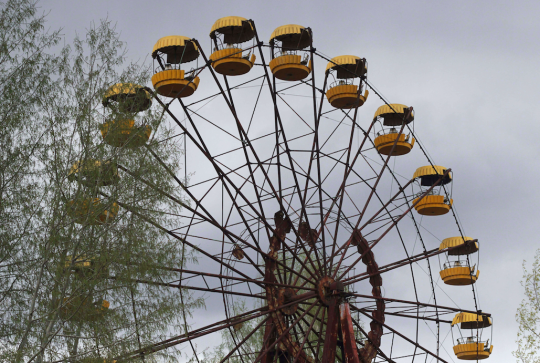
Iconic: The ferris wheel is one of the most famous sights of Pripyat (Rex)
How close do people live to the site?
Towns such as Slavutich in Ukraine are located just over 40 miles away from Chernobyl, and was build to house around 25,000 former exclusion zone residents. Around 3,800 people live on this border of the exclusion zone, many of whom commute in to carry out work on the site. Some 3,000 people live INSIDE the zone for up to 14 days at a time while they perform dangerous work on the factory. Another 400 elderly farmers have also resettled in their old homes following the disaster, not wanting to leave the area they had lived for their entire lives.
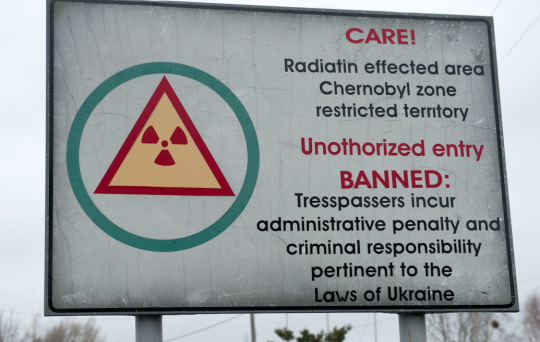
Warning: The exclusion zone remains a restricted area today (Rex)
What is happening to the factory?
After 30 years, work at the power plant continues as around 7,000 people travel in from the outskirts of the exclusion zone to help decommission the plant. Workers must take radiation tests before they return home from their potentially life-threatening jobs. Other workers help to manage the exclusion zone.
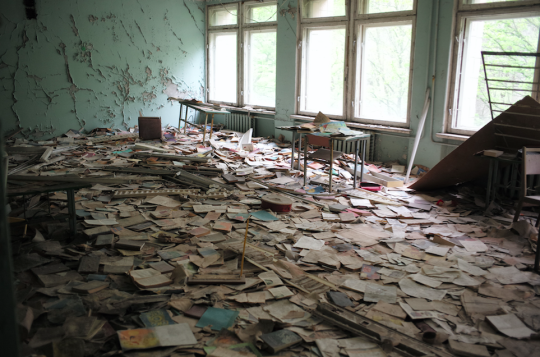
Abandoned: Hundreds of books lie scattered in a floor of a building that was once a school (Rex)
What does the area look like?
Pripyat is an abandoned town, full of empty buildings and deserted homes. Much of the interiors remain untouched since they were abandoned, with children’s toys littered in bedrooms covered in mould and dirt. Rusty beds, deserted fairgrounds and empty swimming pools show an area that was once full of people. Now, nature itself has taken over - with plants and trees slowly spreading across what was once an area filled with human invention.
Has wildlife survived at Chernobyl?
With no human interference, wildlife has flourished at Chernobyl over the past 30 years. In fact, it has become the perfect place for animals to breed without control. The Chernobyl exclusion zone is now home to wolves, bears and horses, among other - although it is not clear how much the animals are affected by diseases as a result of radiation.
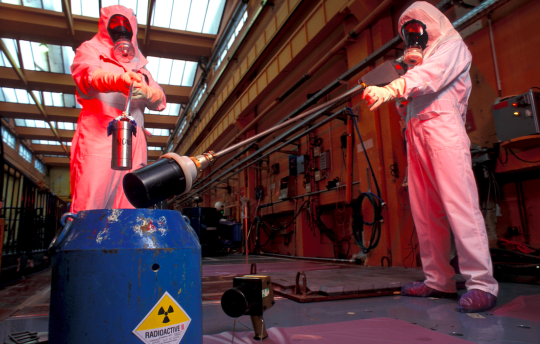
Dangerous: Workers still visit the factory to dismantle it for several hours a day (Rex)
Do residents have a massively increased risk of cancer and other deadly diseases?
The total death toll from cancer from the accident is expected to reach around 4,000 for people exposed to high doses of radiation, according to the United Nations and World Health Organisation. However, they state that there is no evidence of higher rates of death or illness for the 5 million people still living on contaminated lands in Belarus, Russia and Ukraine. Others think the figures are too conservative. Keith Baverstock, a former radiation adviser for the World Health Organisation believes Chernobyl will kill between 30,000 and 60,000 people. At least 28 people were killed in the initial Chernobyl explosion.
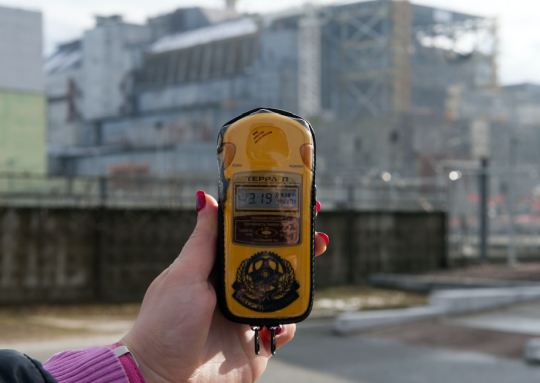
Tests: Radiation levels are still higher than the norm close to the factory (Rex)
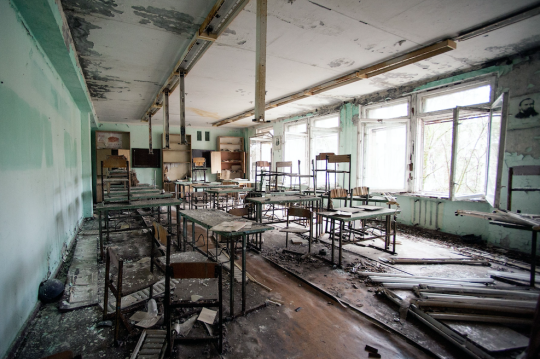
Desolate: Buildings lie in ruins after being left to waste away (Rex)
Are newborns at risk of birth defects as a result of radiation?
The short answer is yes - children are still being born with severe birth defects and rare types of cancer in areas close to Chernobyl, 30 years on from the accident. According to British charity Bridges to Belarus, women who have lived their lives exposed to high levels of radiation are starting to have children with some alarming deformities. Severe cases have included a baby born with two heads and other with missing limbs. An unusually high number of children are also stricken by thyroid cancer - in an area where state healthcare is lacking.
How much radiation still exists in the area?
Following the explosion, there was so much radiation inside the reactor and control room of the plant that death would occur in just one minute. Today, workers inside the exclusion zone work for three weeks inside before spending three weeks outside of it. They are only permitted to work for five hours a day. Any longer is thought to be too dangerous and the levels of radiation at Pripyat are still far higher than the norm.

Hotspot: Tourists flock to the area to see the abandoned streets for themselves (Rex)
When will the area become inhabitable?
While people do still live close to the exclusion zone, Ukrainian officials do not think the area will be completely safe for humans to live for at least another 20,000 years.
Can anyone visit Chernobyl?
Surprisingly, tourists do flock to the area every year to tour Pripyat, Chernobyl and its surrounding areas. Day passes must be obtained by the government through tour companies. Visitors are usually not permitted to enter any of the buildings while many bring radiation masks to protect themselves. Tourists are screened at the end of the day to test their radiation levels. However, it is thought that the amount of time spent near Chernobyl is not necessarily dangerous for those visiting. According to WikiTravel, it takes between 300 and 500 roentgens per hour of radiation to deliver a lethal dose, with levels on the tour ranging from 15 to several hundred micro-roentgens per hour.


